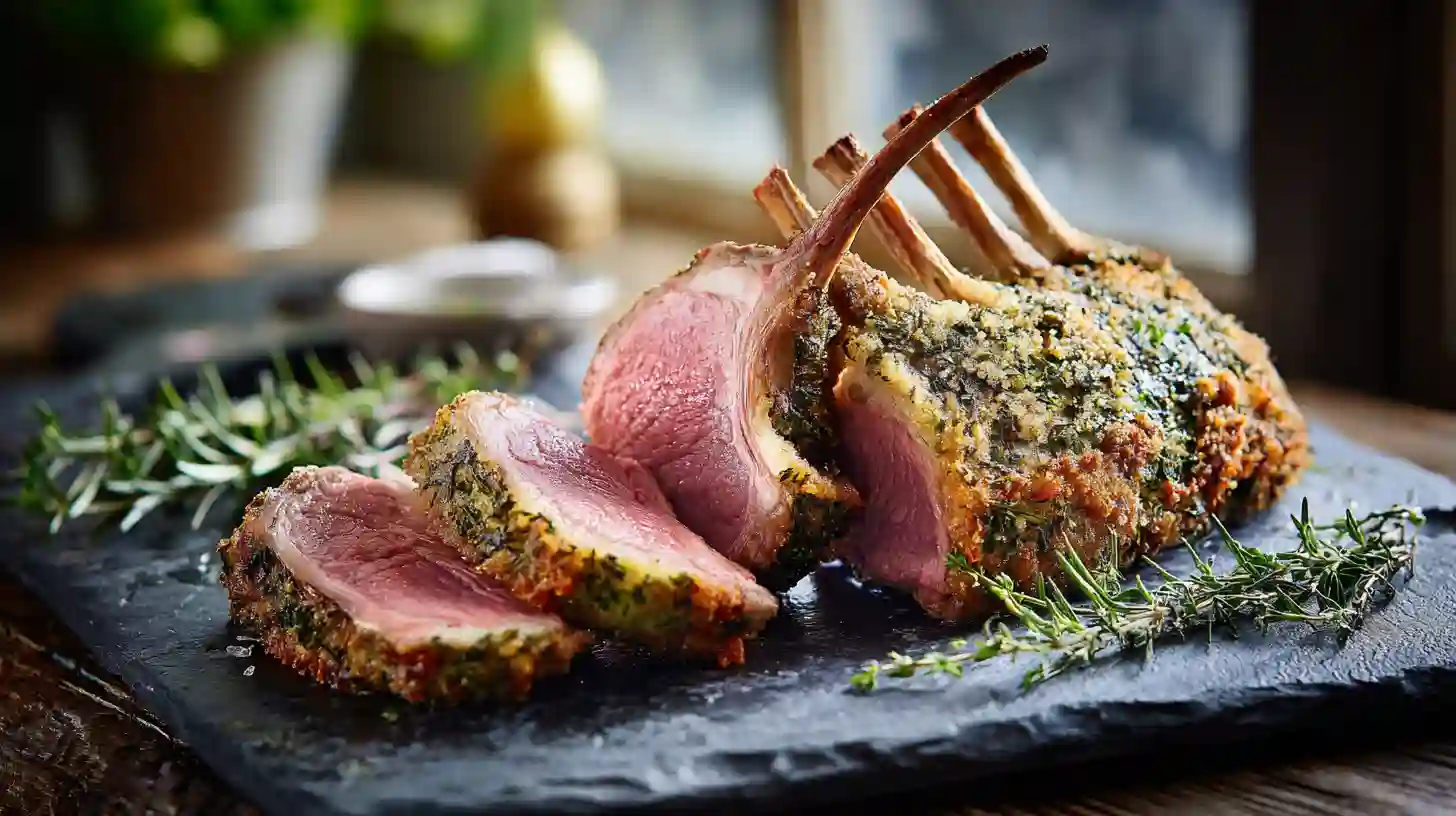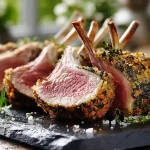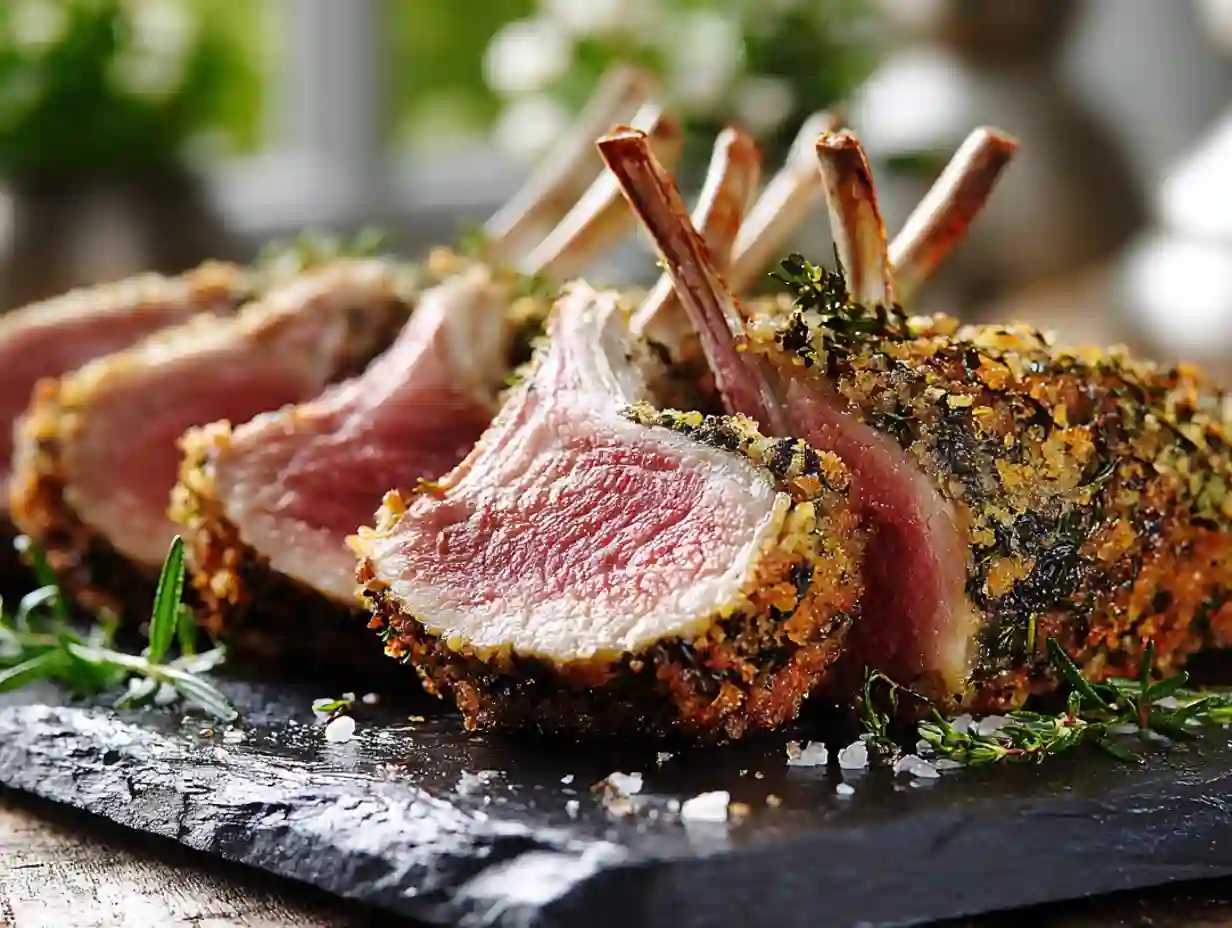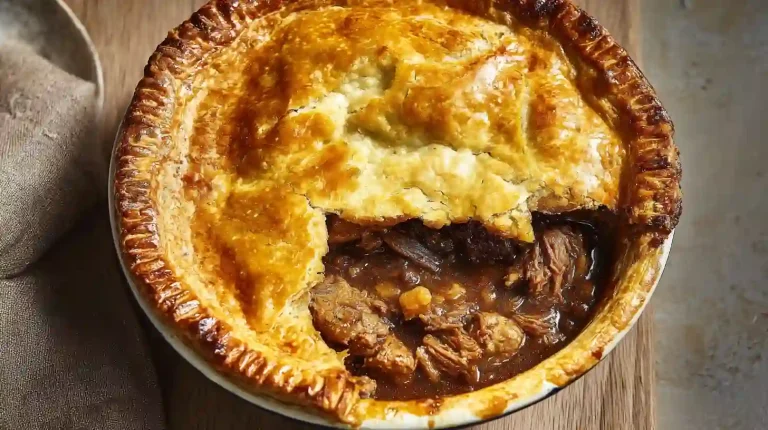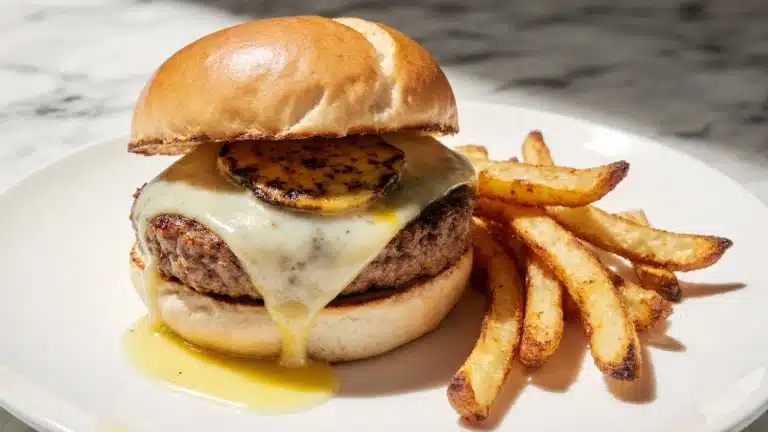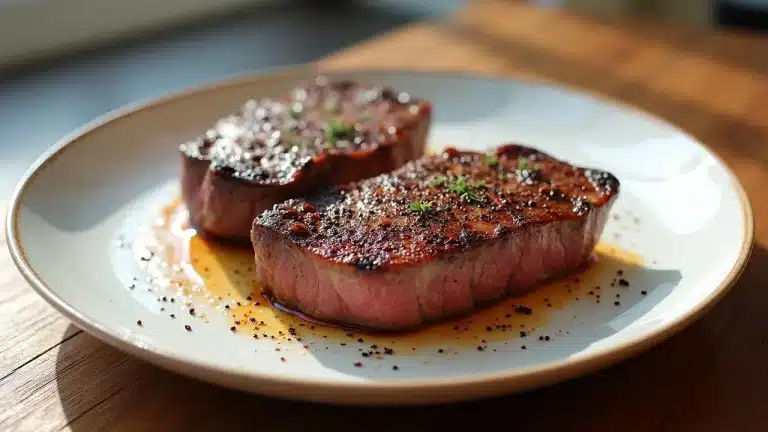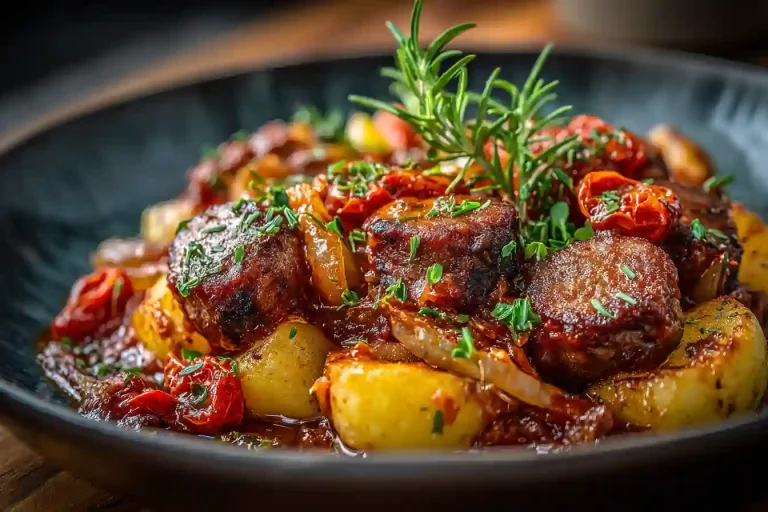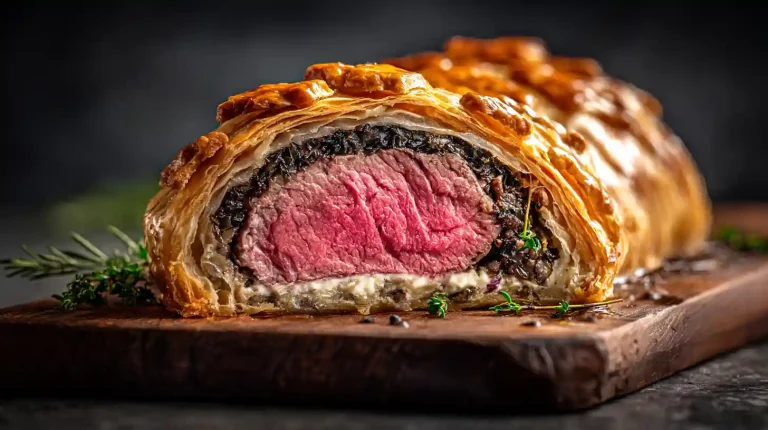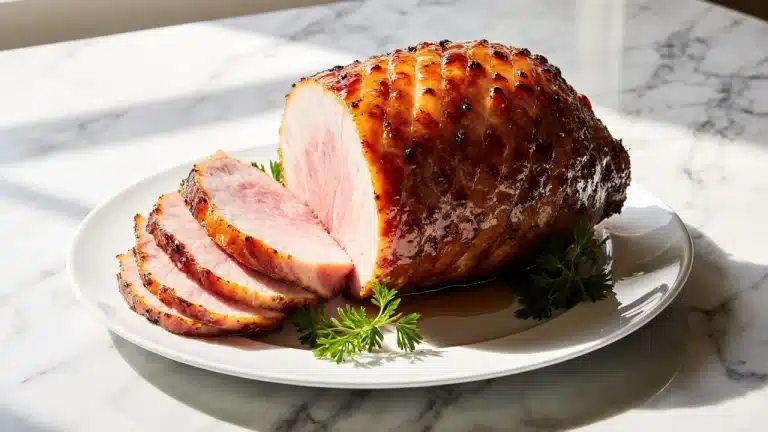Gordon Ramsay Herb Crusted Lamb: The #1 Reason Your Crust Slides Off
Let me tell you about the disaster that was my first attempt at a fancy dinner for my parents. I wanted to impress them. I bought a beautiful, expensive rack of lamb. I watched a dozen videos, blitzed up a gorgeous green herb crust, and carefully packed it onto the raw meat. It looked like something out of a magazine. Then I put it in a hot, oiled skillet.
The sizzle was satisfying for about three seconds. Then, I watched in absolute horror as my entire, perfect crust slumped off the lamb and into the pan, where it instantly began to fry into a bitter, green-black sludge. I served a sad, naked, and slightly burnt rack of lamb that night. It was humiliating.
I’m Mike, and for years I was convinced this dish was impossible for a home cook. But I was wrong. The problem wasn’t my crust recipe or my cooking skills. It was my process. After obsessively studying Gordon Ramsay’s masterclass, I discovered the one secret that changed everything. It’s a simple technique that acts like a savory superglue, and it’s the key to a flawless, restaurant-worthy gordon ramsay herb crusted lamb, every single time. I’m going to share it with you so you never have to serve a naked rack of lamb again.
The Ramsay Way: The 3 Secrets I Finally Understood
Mastering this dish isn’t about one big thing; it’s about understanding three small, non-negotiable laws. I had to learn them the hard way.
Law #1: Sear First, Crust Later. You must sear the lamb on its own first. This builds a foundational flavor crust, renders some fat, and gives the meat a head start. Putting a delicate breadcrumb crust into a screaming-hot pan is a recipe for a burnt, sliding disaster. This is the first step to a perfect gordon ramsay herb crusted lamb.
Law #2: The Dijon Glue. This is the game-changer. After searing and letting the lamb cool for a minute, you brush it generously with Dijon mustard. Think of it as a flavorful primer for paint. It’s not just for taste; it’s the adhesive that makes the herb crust stick like it’s bolted on. It also keeps the meat incredibly moist.
Law #3: Finish in the Oven. Once the crust is on, the aggressive heat of the pan is its enemy. The final cooking for your herb crusted lamb happens in the oven at a moderate, controlled temperature. This gently cooks the lamb to a perfect pink medium-rare while turning the crust a beautiful golden-brown, without a hint of bitterness or burning.
Mistake Watchouts: Let Me Tell You How I Failed
My disaster story is worth repeating because it’s where everyone goes wrong. My first mistake was hubris. I thought, “How hard can it be?” My second mistake was treating the crust like a breading for fried chicken. I packed it on the raw, slightly damp lamb and hoped for the best.
The moment it hit the hot oil, I knew I was in trouble. The side with the crust steamed instead of seared. When I tried to flip it, the whole thing just… separated. I was left with two distinct items in my pan: a rapidly burning pile of green mush, and a now-unseasoned piece of lamb.
In a panic, I scraped the burnt bits out and tried to finish the lamb, but the damage was done. My kitchen smelled like acrid, burnt parsley. The lamb was tough and gray on the outside and practically raw in the middle. I hadn’t just failed; I had disrespected an expensive cut of meat. This was not the gordon ramsay herb crusted lamb I had dreamed of. It was a texture and flavor nightmare. Don’t do what I did. Don’t skip the sear, and don’t forget the glue. You’ve already made the mistakes through my story, so you don’t have to make them in your kitchen.
The Tools of the Trade: Your Essential Gear
Before we get to the recipe, let’s talk gear. You don’t need a professional kitchen, but three pieces of equipment are non-negotiable for success with this gordon ramsay herb crusted lamb recipe.
A Good Oven-Safe Skillet: You need a pan that can go from the stovetop directly into the oven. A 12-inch cast iron or heavy-based stainless steel skillet is perfect.
A Food Processor: To get that fine, uniform, vibrant green crust, a food processor is your best friend. If you don’t have one, you can chop by hand, but be prepared for a workout—it needs to be incredibly fine.
A Digital Meat Thermometer: This is not a suggestion; it’s your contract with perfection. It is the only way to know for sure when your lamb is a perfect medium-rare. Don’t guess. Don’t “feel” it. Use a thermometer.
The Recipe: Herb Crusted Rack of Lamb
Gordon Ramsay’s Herb Crusted Rack of Lamb (Foolproof Method)
Ingredients
Equipment
Method
- Prep: Preheat oven to 400°F (200°C). Pat lamb racks completely dry with paper towels and season generously on all sides with salt and pepper.
- Sear: Heat olive oil in a large, oven-safe skillet over medium-high heat. Sear lamb for 2-3 minutes on the fat side, then 1-2 minutes on all other sides. Remove from pan and set aside to cool slightly.
- Make Crust: In a food processor, pulse garlic and fresh herbs until finely chopped. Add Panko breadcrumbs, melted butter, and a pinch of salt and pepper. Pulse until the mixture resembles vibrant green sand.
- Apply ‘Glue’ & Crust: Once lamb is cool enough to handle, brush a generous, even layer of Dijon mustard over the fat-cap. Firmly press the herb mixture onto the mustard to create a thick, even crust.
- Roast: Return racks to the skillet, crust-side up. Roast for 15-20 minutes, or until a meat thermometer inserted into the thickest part (avoiding bone) reads 125°F (52°C) for medium-rare.
- Rest: Transfer lamb to a cutting board and let it rest for 10 minutes. The internal temperature will rise slightly as the juices redistribute. Do not skip this step.
- Serve: Slice the rack between the bones into individual chops and serve immediately.
Nutrition
Notes
Love this recipe?
Give us 5 stars and comment!The Cast of Characters: Your Ingredient Lineup
Great ingredients are the foundation. Don’t compromise here, especially on the herbs. For the authentic gordon ramsay herb crusted lamb, quality is key.
- 2 (8-bone) racks of lamb, about 2 lbs (900g) total, ask your butcher to ‘French’ the bones to save you the trouble.
- 2 tablespoons olive oil
- Salt and freshly ground black pepper
- 4 tablespoons (60ml) Dijon mustard, Don’t use yellow mustard, it’s not the same!
- For the Crust:
- 4 cloves garlic, peeled
- 1/2 cup (30g) fresh parsley leaves
- 2 tablespoons fresh rosemary leaves
- 2 tablespoons fresh thyme leaves
- 1/2 cup (60g) Panko or fresh breadcrumbs, Panko gives a lighter, crispier crust.
- 2 tablespoons butter, melted
- A pinch of salt and pepper
The Execution: Step-by-Step
- Prep the Lamb: Preheat your oven to 400°F (200°C). Pat the racks of lamb completely dry with paper towels. This is crucial for a good sear. Season them generously on all sides with salt and pepper.
- Sear the Lamb: Heat the olive oil in your large, oven-safe skillet over medium-high heat until it shimmers. Carefully place the lamb in the pan, fat-side down. Sear for 2-3 minutes until the fat is rendered and golden brown. Sear all other sides for about 1-2 minutes each. Remove the lamb from the pan and place it on a cutting board.
- Make the Crust: While the pan is off the heat, add the garlic, parsley, rosemary, and thyme to your food processor. Pulse until everything is finely chopped. Add the breadcrumbs, melted butter, salt, and pepper and pulse a few more times until it looks like vibrant green sand.
- Apply the “Dijon Glue”: Once the lamb is cool enough to handle (about 5 minutes), brush a generous, even layer of Dijon mustard over the fat-cap side of each rack. This is the most critical step for the gordon ramsay herb crusted lamb.
- Pack on the Crust: Press the herb mixture firmly onto the mustard-coated side of the lamb. The mustard will act as a glue. Don’t be shy; pack it on.
- Roast to Perfection: Return the crusted racks to the skillet, crust-side up. Insert a meat thermometer into the thickest part of the meat, avoiding the bone. Roast for 15-20 minutes, or until the thermometer reads 125°F (52°C) for a perfect medium-rare. The crust should be golden and fragrant.
- REST THE MEAT: This is the final, critical step. Transfer the lamb to a cutting board and let it rest for 10 minutes before slicing. The temperature will rise a few more degrees, and the juices will redistribute. Do not skip this!
Fun Riffs (That Don’t Break the Rules)
Once you’ve mastered the Dijon Glue Method for this gordon ramsay herb crusted lamb, you can get creative. The rules are: sear first, use the glue, and finish in the oven. As long as you follow those, feel free to experiment.
- Pistachio Crust: Swap half the breadcrumbs for finely chopped pistachios. It’s a classic, delicious variation.
- Go Minty: Swap the rosemary and thyme for fresh mint for a classic pairing.
- Add Some Zest: Add the zest of one lemon to the food processor for a bright, citrusy note in the crust.
Show It Off: Plating the Right Way
You worked hard for that perfect crust and pink center, so show it off! After resting, slice the rack between the bones into individual or double chops. The best way to plate is to stand two or three chops up on the plate, interlocking the bones so they support each other. It gives the dish height and looks incredibly professional. A little drizzle of the pan juices over the top is all you need.
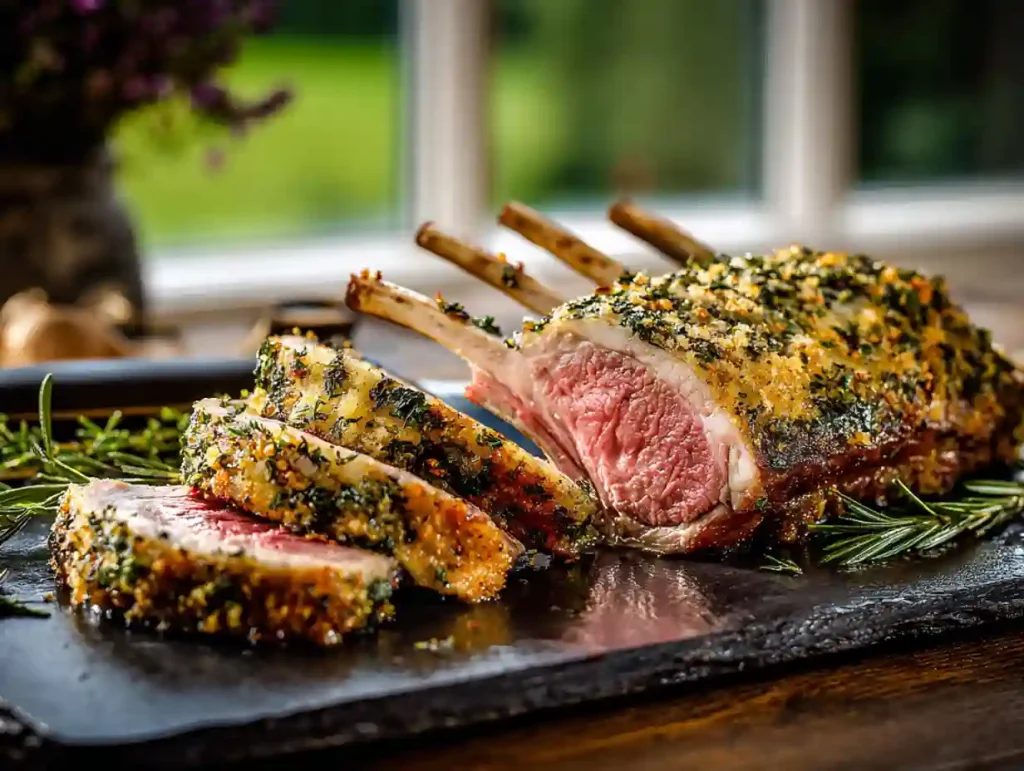
Recipe FAQs
Is this the official gordon ramsay herb crusted lamb recipe from MasterChef?
This method is based directly on the principles Gordon Ramsay teaches in his MasterClass, which are consistent with what’s shown on his programs. It focuses on the core techniques that guarantee a perfect result every time.
Can I use dried herbs for the crust?
I strongly advise against it. Dried herbs burn much more easily than fresh ones and can become bitter in the oven. Fresh herbs are essential for the flavor and color of this herb crusted lamb.
What if I don’t have a food processor?
You can absolutely chop everything by hand. Just make sure you chop the herbs and garlic extremely finely before mixing them with the breadcrumbs. It will take more time, but it’s doable.
What sauce should I serve with this?
The pan juices after resting the meat make a fantastic simple sauce. For something more, a classic mint sauce or a red wine reduction works beautifully with this gordon ramsay herb crusted lamb.
My lamb was still too rare/overcooked! What happened?
You didn’t use a meat thermometer, did you? Ovens vary, and lamb racks vary in thickness. The only way to guarantee the doneness you want is to cook to temperature, not to time. 125°F (52°C) for medium-rare is the magic number before resting.
The Result: Was It Worth It?
Absolutely, one hundred percent, yes. When you take that first slice, you’ll hear the gentle crunch of the perfect crust giving way. You’ll see the flawless, wall-to-wall pink of the medium-rare meat, with not a hint of a gray band. The aroma of roasted garlic, herbs, and rich lamb will fill the room. The taste is sublime—the savory, crisp crust, the tangy bite of the Dijon, and the tender, juicy lamb. This isn’t just a meal; it’s a triumph. It’s the moment you realize you can cook the perfect gordon ramsay herb crusted lamb.
Your Turn. Get to Work.
Alright, you have the blueprint. You know the secrets. You’ve seen my failures so you can skip straight to success. The only thing left is to do it. Get in the kitchen, grab a rack of lamb, and make something incredible.
Find more foolproof guides on our Gordon Ramsay’s Beef & Lamb Recipes page.

